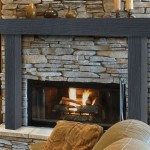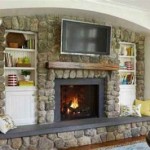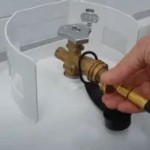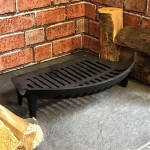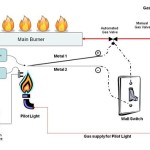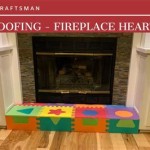Faux Stone Fireplaces: Aesthetics, Advantages, and Installation
Faux stone fireplaces offer a compelling alternative to traditional masonry fireplaces. They provide the visual appeal of natural stone without the structural complexities, weight burden, and often prohibitive costs associated with the real thing. This article explores the defining characteristics of faux stone fireplaces, details their advantages, and provides an overview of the installation process.
The term "faux stone" encompasses a range of manufactured materials designed to mimic the appearance and texture of natural stone. These materials typically consist of a lightweight concrete mix or polyurethane resin aggregate, molded and colored to replicate various stone types, including river rock, fieldstone, stacked stone, and ledgestone. The resulting veneers are significantly lighter and easier to handle than their natural counterparts, making them suitable for a wider range of applications and structural support systems.
Faux stone fireplaces are not limited to a specific architectural style. They can be adapted to complement contemporary, rustic, traditional, or modern designs. The versatility stems from the variety of stone profiles, colors, and textures available. This allows homeowners to customize the fireplace to match the existing décor or to create a focal point that defines the room's aesthetic. The integration of mantels, hearths, and other architectural details further enhances the design possibilities.
Benefits of Choosing Faux Stone
The appeal of faux stone fireplaces lies in their numerous advantages over real stone. These benefits span cost-effectiveness, ease of installation, design flexibility, and reduced maintenance requirements.
Cost-Effectiveness: The initial cost of faux stone is typically lower than that of natural stone. The price difference reflects the manufacturing process versus the quarrying, transportation, and cutting of natural stone. Furthermore, the reduced weight of faux stone often translates to lower shipping costs and less intensive labor requirements during installation. This cumulative effect can result in significant savings on the overall fireplace project.
Ease of Installation: Faux stone veneers are significantly lighter than real stone, simplifying the installation process. This reduces the need for specialized equipment and skilled labor. Many homeowners with intermediate DIY skills can install faux stone veneers themselves, further reducing costs. The veneers are typically adhered to a prepared surface using mortar or construction adhesive. The interlocking or panelized designs of some faux stone products also contribute to faster and more efficient installation.
Design Flexibility: Faux stone offers unparalleled design flexibility. Manufacturers can replicate a wide range of stone types, colors, and textures with consistent accuracy. This allows homeowners to achieve a specific aesthetic without the limitations imposed by the availability or natural variations of real stone. Furthermore, faux stone can be easily cut and shaped to fit complex architectural designs, enabling custom fireplace surrounds and unique design features.
Reduced Weight and Structural Requirements: The lightweight nature of faux stone reduces the structural demands on the building. Unlike real stone fireplaces, which can require reinforced foundations and walls, faux stone fireplaces can often be installed on existing structures without significant modifications. This makes them suitable for retrofitting into older homes or installing in rooms with limited structural capacity. The reduction in weight also minimizes the risk of settling or cracking over time.
Durability and Low Maintenance: Faux stone is designed to withstand the elements and resist fading, cracking, and chipping. It is typically treated with a sealant to protect it from moisture and stains. Unlike natural stone, which may require periodic sealing and cleaning to maintain its appearance, faux stone requires minimal maintenance. Regular dusting or occasional washing with mild soap and water is usually sufficient to keep it looking its best.
Eco-Friendliness: While not always the primary consideration, faux stone can be a more environmentally friendly option than natural stone. The manufacturing process often utilizes recycled materials, reducing the demand for quarrying new stone. Furthermore, the reduced weight of faux stone translates to lower transportation costs and reduced carbon emissions. Choosing faux stone can contribute to a more sustainable approach to home construction and renovation.
Types of Faux Stone Materials
While the overall goal is to mimic natural stone, the materials used to create faux stone vary, influencing both the appearance and the performance characteristics of the finished product.
Concrete-Based Faux Stone: This is the most common type of faux stone. It consists of a lightweight concrete mix, typically incorporating aggregates such as sand, gravel, or expanded shale. Pigments are added to the mix to achieve the desired color and texture. Concrete-based faux stone is durable, fire-resistant, and relatively affordable. It can be molded into a wide range of shapes and sizes, replicating various stone profiles.
Polyurethane Faux Stone: This type of faux stone is made from high-density polyurethane foam. It is extremely lightweight and easy to install. Polyurethane faux stone is also water-resistant and requires minimal maintenance. However, it is generally less durable than concrete-based faux stone and may be more susceptible to scratching or damage. It's also less fire resistant and typically carries flammability ratings that must be considered when installing around fireplaces.
Hybrid Faux Stone: Some manufacturers offer hybrid faux stone products that combine different materials to achieve a specific balance of properties. For example, a hybrid faux stone may consist of a concrete base with a polymer coating to enhance its durability and water resistance. These hybrid materials often offer a combination of the benefits of both concrete-based and polyurethane faux stone.
The choice of material depends on the specific application, budget, and desired aesthetic. Concrete-based faux stone is generally preferred for larger projects or applications where durability and fire resistance are paramount. Polyurethane faux stone is often used for smaller projects or applications where weight and ease of installation are key considerations. Hybrid faux stone offers a compromise between these two options.
Installation Considerations
Proper installation is crucial to ensure the longevity and aesthetic appeal of a faux stone fireplace. The installation process typically involves several key steps, including surface preparation, adhesive application, and veneer placement.
Surface Preparation: The surface to which the faux stone is applied must be clean, dry, and structurally sound. For masonry surfaces, this may involve removing loose mortar, cleaning the surface with a wire brush, and applying a bonding agent to improve adhesion. For non-masonry surfaces, such as drywall or plywood, it may be necessary to install a layer of cement backer board to provide a suitable substrate. The surface should be level and free of any irregularities that could affect the appearance of the finished fireplace.
Adhesive Application: The choice of adhesive depends on the type of faux stone being used and the substrate to which it is being applied. Mortar is typically used for concrete-based faux stone, while construction adhesive may be used for polyurethane faux stone. The adhesive should be applied according to the manufacturer's instructions, ensuring that it is evenly distributed and provides adequate coverage. A notched trowel can be used to create ridges in the adhesive, which helps to improve adhesion and prevent air pockets.
Veneer Placement: The faux stone veneers should be installed in a staggered pattern to create a natural look. The veneers should be pressed firmly into the adhesive, ensuring that they are properly aligned and level. Spacers can be used to maintain consistent joint widths. Excess adhesive should be removed immediately with a damp sponge. It is important to consult the manufacturer's instructions for specific recommendations on veneer placement and jointing techniques.
Cutting and Shaping: Faux stone can be cut and shaped using a variety of tools, including a wet saw, a circular saw with a masonry blade, or a chisel. A wet saw is recommended for cutting concrete-based faux stone, as it helps to control dust and prevent chipping. A circular saw can be used for polyurethane faux stone, but it is important to use a sharp blade and to cut slowly to avoid melting the material. A chisel can be used to create irregular edges or to shape the veneers to fit around corners or other architectural features.
Sealing and Finishing: Once the faux stone is installed, it should be sealed to protect it from moisture and stains. A high-quality masonry sealer should be applied according to the manufacturer's instructions. The sealer will help to prevent water penetration and to make the faux stone easier to clean. The joints between the veneers can be filled with grout or left open, depending on the desired aesthetic. If grout is used, it should be applied carefully to avoid staining the faux stone.
Safety Precautions: When installing faux stone, it is important to wear appropriate safety gear, including gloves, eye protection, and a dust mask. Power tools should be used with caution, following all safety instructions provided by the manufacturer. The work area should be well-ventilated to prevent the buildup of dust and fumes. It is also important to follow all local building codes and regulations.
The installation of a faux stone fireplace is a rewarding project that can significantly enhance the aesthetic appeal and value of a home. By carefully considering the material selection, design, and installation techniques, homeowners can create a beautiful and durable fireplace that will provide years of enjoyment.
Design Ideas and Inspiration
The design possibilities for faux stone fireplaces are virtually limitless. The wide range of stone profiles, colors, and textures allows homeowners to create a fireplace that perfectly complements their personal style and the overall aesthetic of their home.
Rustic Fireplaces: Rustic fireplaces typically feature natural-looking stone profiles, such as river rock, fieldstone, or stacked stone. Earthy colors, such as browns, grays, and tans, are commonly used to create a warm and inviting atmosphere. Rustic fireplaces often incorporate reclaimed wood mantels and hearths to enhance the natural aesthetic.
Modern Fireplaces: Modern fireplaces often feature sleek and minimalist designs. Linear stone profiles, such as ledgestone or stacked stone, are frequently used to create a clean and contemporary look. Neutral colors, such as white, gray, and black, are often preferred. Modern fireplaces may incorporate stainless steel accents or glass panels to add a touch of sophistication.
Traditional Fireplaces: Traditional fireplaces typically feature classic stone profiles, such as brick or castle stone. Warm and inviting colors, such as reds, browns, and creams, are commonly used. Traditional fireplaces often incorporate ornate mantels and hearths, adding a touch of elegance to the room.
Outdoor Fireplaces: Faux stone is an excellent choice for outdoor fireplaces. Its durability and weather resistance make it ideal for withstanding the elements. Outdoor fireplaces can be designed to complement the surrounding landscape, creating a cozy and inviting outdoor living space.
The key to designing a successful faux stone fireplace is to carefully consider the architectural style of the home, the desired aesthetic, and the available space. By exploring different stone profiles, colors, and textures, homeowners can create a fireplace that is both beautiful and functional. Consulting with a design professional can also be helpful in developing a cohesive and visually appealing fireplace design.

Jerre S Faux Stone Fireplace Surround Genstone

Stone Fireplace Design And Remodel

ᑕ❶ᑐ Faux Stone Electric Fireplace Where Does It Match Best

Stone Veneer Fireplace Ideas That Will Warm Up Your Home Ply Gem

Faux Stone For Fireplaces

11 Stone Veneer Fireplace Surround Design Trends Where To Buy

Stone Fireplace Design And Remodel

Stone Fireplace Makeover Part 2 Faux Whitewash Organized Ish

43 Top Fireplace Interior Design Stacked Stone Fireplaces Faux Veneer

Great Designs For Faux Stone Fireplaces And How To Diy
Related Posts

